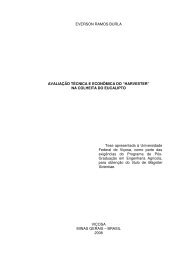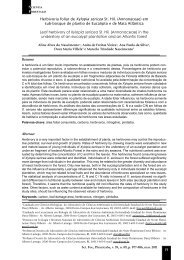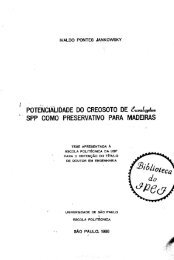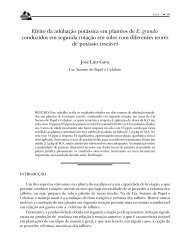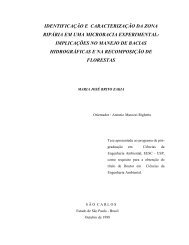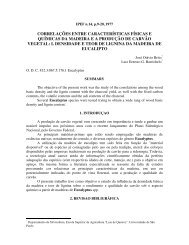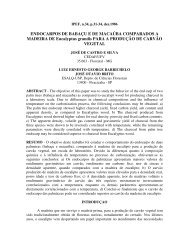UNIVERSIDAD AUSTRAL DE CHILE - Ipef
UNIVERSIDAD AUSTRAL DE CHILE - Ipef
UNIVERSIDAD AUSTRAL DE CHILE - Ipef
You also want an ePaper? Increase the reach of your titles
YUMPU automatically turns print PDFs into web optimized ePapers that Google loves.
8 SUMMARY<br />
With the objective to evaluating options of nutritional management in Eucalyptus<br />
nitens, at the canopy closure (45 months old) in a red clay soils (serie Crucero, X Region,<br />
Chile), the yield (DAP, basal area and volume) of eleven fertilization treatments that<br />
combined sources of phosphorous of different solubility and lime, were compared.<br />
Whereas, in the treatment with more P application and in the control (unfertilized), the<br />
basic wood density, biomass accumulation (leaves, live branches, dead branches, bark,<br />
wood and roots), litter accumulation and the annual litterfall, were determined. In the<br />
biomass components, in the litterfall and in the litter, the concentration and the quantity of<br />
N, P, K Ca, Mg, Fe, Mn, Cu, Zn and B were determined. Likewise, in the fertilized and in<br />
the control treatments, the concentration and nutrients content of soil exchangeable<br />
fraction and soil reserve fraction, until the 30 cm of depth, were determined. In both<br />
treatments, the nutritious balance and the Reservation Vegetation Index were<br />
determined.<br />
The biggest response in yield was detected in the treatment with soluble phosphorous<br />
applied to the beginning of the plantation and the beginning of the second year of growth.<br />
In turn, the drop response to the less soluble phosphorous would be attributed to the<br />
magnitude of the dose, regarding the capacity of fixation of phosphorus of the soil. The<br />
lime didn't produce effects in the yield. The wood basic density increased significantly for<br />
effect of the fertilization. The above-ground biomass in the fertilized treatment (90,4 t ha -1 )<br />
it was 55 % bigger than the control (58,1 t ha -1 ). The litterfall evidenced a fall maxim in<br />
summer and minimum in winter. The nutrient levels in the soil exchange fraction went<br />
similar to those evaluated to the beginning of the plantation. The sequence of nutrients<br />
concentration was leaves > fine roots > bark > branches > coarse roots > wood, and in<br />
the part of the tree, upper > middle > low that which pointed out the efficiency of E. nitens<br />
to transfer nutrients toward more active tissues. Until forty five months old, E. nitens<br />
accumulated in the above-ground biomass and litter of the fertilized treatment 30 % more<br />
than Ca and Mg and 10% more than N, P and K regarding the control. The average<br />
accumulated in both treatments was (kg ha -1 ): 485 N, 26 P, 300 K, 450 kg Ca and 38 Mg.<br />
The nutritious balance and the Vegetation Reserve Index identified that the soil is<br />
unstable in K, P and Ca contents, conversely, the soil is stable in the Mg content.<br />
150



